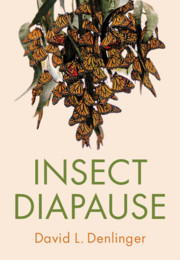Book contents
- Insect Diapause
- Insect Diapause
- Copyright page
- Dedication
- Contents
- Preface
- 1 Confronting the Challenges of a Seasonal Environment
- 2 Which Seasons Are Being Avoided?
- 3 Variation in the Diapause Response
- 4 The Cost of Diapause and Some Diapause Alternatives
- 5 Interpreting Seasonal Cues to Program Diapause Entry
- 6 Preparing for Diapause
- 7 The Diapause State
- 8 Ending Diapause and Reinitiating Development
- 9 Molecular Signaling Pathways that Regulate Diapause
- 10 Genetic Control of Diapause
- 11 Evolution of Diapause
- 12 Wider Implications
- References
- Species Index
- Subject Index
- Plate Section (PDF Only)
6 - Preparing for Diapause
Published online by Cambridge University Press: 13 January 2022
- Insect Diapause
- Insect Diapause
- Copyright page
- Dedication
- Contents
- Preface
- 1 Confronting the Challenges of a Seasonal Environment
- 2 Which Seasons Are Being Avoided?
- 3 Variation in the Diapause Response
- 4 The Cost of Diapause and Some Diapause Alternatives
- 5 Interpreting Seasonal Cues to Program Diapause Entry
- 6 Preparing for Diapause
- 7 The Diapause State
- 8 Ending Diapause and Reinitiating Development
- 9 Molecular Signaling Pathways that Regulate Diapause
- 10 Genetic Control of Diapause
- 11 Evolution of Diapause
- 12 Wider Implications
- References
- Species Index
- Subject Index
- Plate Section (PDF Only)
Summary
The fact that diapause is programmed well in advance of its onset enables the insect to take preparative steps supporting its upcoming period of developmental arrest. Such steps frequently include modifications in the rate of pre-diapause development (most commonly a prolongation but sometimes an acceleration in development), acquisition of additional energy reserves (usually in the form of lipids), local or distant migration to overwintering sites, selection of a suitable microenvironment for spending the months of diapause, enhancement of the refuge (additional waterproofing, etc.), formation of aggregations, adjusting color to blend with the diapause environment, and making structural modifications (e.g., short- vs. long-winged forms), and, as seen in aphids, switching reproductive modes from parthenogenesis to sexual reproduction. These sorts of pervasive changes that occur even before diapause begin to underscore the idea that diapause is most appropriately viewed as an alternative life cycle, impacting more than just the diapause state.
Keywords
- Type
- Chapter
- Information
- Insect Diapause , pp. 121 - 150Publisher: Cambridge University PressPrint publication year: 2022
- 1
- Cited by

